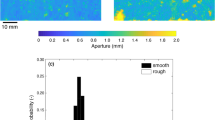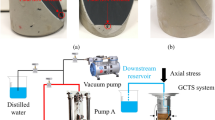Abstract
In order to investigate geophysical indicators of permeability changes in subsurface fractures, we conducted an experimental study on the hydraulic–mechanical–seismic coupled behaviors of granite fractures with surface roughness under stress conditions during hydraulic shearing. Our laboratory experiment yielded the following insights: (1) The “self-propping shear slip concept” unequivocally serves as the primary mechanism for maintaining the increase in fracture permeability of granite, even under stress conditions exceeding approximately 50 MPa. (2) The Gutenberg–Richter b-value gradually decreases during shear dilation and accompanying increase in fracture permeability. Thus, it could serve as an indicator for assessing changes in fracture permeability. (3) The evolution amplitude in acoustic emissions (AEs), as well as the classification of tensile/shear modes and the timing of our maximum amplitude of AE occurrence, do not seem to provide useful information for estimating fracture permeability changes during hydraulic shear slip. The reduction in b-value can be attributed to the spontaneous formation of preferential flow paths during the injection of pressurized fluid into the rock fracture and the subsequent detachment of the small contacting asperities due to localized shear slips, which naturally lead to the creation of porosity and irreversible increase in fracture permeability.
Highlights
-
Hydraulic-mechanical-seismic coupled behaviors of granitic fracture are investigated during hydraulic shearing experiments in the laboratory.
-
b-value gradually decreases during shear dilation and associated permeability increase of granitic fracture with rough surfaces.
-
There is no clear correlation between fracture permeability change and amplitude/occurrence timing of AEmax amp. during hydraulic shearing.










Similar content being viewed by others
Data availability statement
The data to reproduce this work are available from the corresponding author: Takuya Ishibashi (takuya.ishibashi@aist.go.jp).
References
Barton N, Choubey V (1977) The shear strength of rock joints in theory and practice. Rock Mech 10(1–2):1–54. https://doi.org/10.1007/BF01261801
Berkowitz B, Bour O, Davy P, Odling N (2000) Scaling of fracture connectivity in geological formations. Geophys Res Lett 27(14):2061–2064. https://doi.org/10.1029/1999GL011241
Bolton DC, Shreedharan S, Rivière J, Marone C (2021) Frequency-magnitude statistics of laboratory foreshocks vary with shear velocity, fault slip rate, and shear stress. J Geophys Res Solid Earth. https://doi.org/10.1029/2021JB022175
Bonnet E, Bour O, Odling NE, Davy P, Main I, Cowie P, Berkowitz B (2001) Scaling of fracture systems in geological media. Rev Geophys 39(3):347–383. https://doi.org/10.1029/1999RG000074
Brown SR (1989) Transport of fluid and electric current through a single fracture. J Geophys Res Solid Earth 94(B7):9429–9438. https://doi.org/10.1029/JB094iB07p09429
Brown SR, Scholz CH (1985) Broad bandwidth study of the topography of natural rock surfaces. J Geophys Res Solid Earth 90(B14):12575–12582. https://doi.org/10.1029/JB090iB14p12575
Cornet FH (2015) Elements of crustal geomechanics. Cambridge University Press
Ellsworth WL (2013) Injection-induced earthquakes. Science 341(6142):1225942. https://doi.org/10.1126/science.1225942
Evans KF, Genter A, Sausse J (2005) Permeability creation and damage due to massive fluid injections into granite at 3.5 km at Soultz 1. Borehole observations: PERMEABILITY CREATION IN GRANITE. J Geophys Res Solid Earth. https://doi.org/10.1029/2004JB003168
Fang Y, Elsworth D, Cladouhos TT (2018) Reservoir permeability mapping using microearthquake data. Geothermics 72:83–100. https://doi.org/10.1016/j.geothermics.2017.10.019
Feng X-T, Young RP, Reyes-Montes JM, Aydan Ö, Ishida T, Liu J-P, Liu H-J (2019) ISRM suggested method for in situ acoustic emission monitoring of the fracturing process in rock masses. Rock Mech Rock Eng 52(5):1395–1414. https://doi.org/10.1007/s00603-019-01774-z
Fu P, Schoenball M, Ajo-Franklin JB, Chai C, Maceira M, Morris JP, Wu H, Knox H, Schwering PC, White MD, Burghardt JA, Strickland CE, Johnson TC, Vermeul VR, Sprinkle P, Roberts B, Ulrich C, Guglielmi Y, Cook PJ (2021) Close observation of hydraulic fracturing at EGS collab experiment 1: fracture trajectory, microseismic interpretations, and the role of natural fractures. J Geophys Res Solid Earth. https://doi.org/10.1029/2020JB020840
Fujii Y, Takemura T, Takahashi M, Lin W, Akaiwa S (2005) The feature of uniaxial tensile fractures in granite and their relation to rock anisotropy. Jour Japan Soc Eng Geol 46(4):227–231. https://doi.org/10.5110/jjseg.46.227
Ge S, Saar MO (2022) Review: induced seismicity during geoenergy development—a hydromechanical perspective. J Geophys Res Solid Earth. https://doi.org/10.1029/2021JB023141
Ishibashi T, Watanabe N, Hirano N, Okamoto A, Tsuchiya N (2015) Beyond-laboratory-scale prediction for channeling flows through subsurface rock fractures with heterogeneous aperture distributions revealed by laboratory evaluation. J Geophys Res Solid Earth 120(1):106–124. https://doi.org/10.1002/2014JB011555
Ishibashi T, Watanabe N, Asanuma H, Tsuchiya N (2016) Linking microearthquakes to fracture permeability change: the role of surface roughness: LINKING MEQS TO PERMEABILITY CHANGE. Geophys Res Lett 43(14):7486–7493. https://doi.org/10.1002/2016GL069478
Ishibashi T, Fang Y, Elsworth D, Watanabe N, Asanuma H (2020) Hydromechanical properties of 3D printed fractures with controlled surface roughness: insights into shear-permeability coupling processes. Int J Rock Mech Min Sci 128:104271. https://doi.org/10.1016/j.ijrmms.2020.104271
Ishibashi T, Asanuma H, Mukuhira Y, Watanabe N (2023) Laboratory hydraulic shearing of granitic fractures with surface roughness under stress states of EGS: permeability changes and energy balance. Int J Rock Mech Min Sci 170:105512. https://doi.org/10.1016/j.ijrmms.2023.105512
Jaeger JC, Cook NGW, Zimmerman R (2007) Fundamentals of rock mechanics (Fourth). Wiley-Blackwell, Hoboken
Johnson TC, Burghardt J, Strickland C, Knox H, Vermeul V, White M, Schwering P, Blankenship D, Kneafsey T (2021) 4D Proxy imaging of fracture dilation and stress shadowing using electrical resistivity tomography during high pressure injections into a dense rock formation. J Geophys Res Solid Earth. https://doi.org/10.1029/2021JB022298
Lei X, Tamagawa T, Tezuka K, Takahashi M (2011) Role of drainage conditions in deformation and fracture of porous rocks under triaxial compression in the laboratory: ROLE OF DRAINAGE CONDITIONS IN FAULTING. Geophys Res Lett. https://doi.org/10.1029/2011GL049888
Lin W, Takahashi M, Sugita N (1995) Change of microcrack widths induced by temperature increase in Inada granite. Jour Japan Soc Eng Geol 36(4):34–38. https://doi.org/10.5110/jjseg.36.300
Lin W, Nakamura T, Takahashi M (2003) Anisotropy of thermal property, ultrasonic wave velocity, strength property and deformability in Inada granite. Jour Japan Soc Eng Geol 44(3):175–187. https://doi.org/10.5110/jjseg.44.175
Matsuki K, Chida Y, Sakaguchi K, Glover PWJ (2006) Size effect on aperture and permeability of a fracture as estimated in large synthetic fractures. Int J Rock Mech Min Sci 43(5):726–755. https://doi.org/10.1016/j.ijrmms.2005.12.001
Meng M, Frash LP, Li W, Welch NJ, Carey JW, Morris J, Neupane G, Ulrich C, Kneafsey T (2022) Hydro-mechanical measurements of sheared crystalline rock fractures with applications for egs collab experiments 1 and 2. J Geophys Res Solid Earth. https://doi.org/10.1029/2021JB023000
Norbeck JH, McClure MW, Horne RN (2018) Field observations at the Fenton Hill enhanced geothermal system test site support mixed-mechanism stimulation. Geothermics 74:135–149. https://doi.org/10.1016/j.geothermics.2018.03.003
Oda M, Katsube T, Takemura T (2002) Microcrack evolution and brittle failure of Inada granite in triaxial compression tests at 140 MPa. J Geophys Res Solid Earth. https://doi.org/10.1029/2001JB000272
Ohno K, Ohtsu M (2010) Crack classification in concrete based on acoustic emission. Constr Build Mater 24(12):2339–2346. https://doi.org/10.1016/j.conbuildmat.2010.05.004
Ohtsu M (1996) Quantitative AE techniques standardized for concrete structures. Mag Concr Res 48(177):321–330. https://doi.org/10.1680/macr.1996.48.177.321
Power WL, Tullis TE, Brown SR, Boitnott GN, Scholz CH (1987) Roughness of natural fault surfaces. Geophys Res Lett 14(1):29–32. https://doi.org/10.1029/GL014i001p00029
Rivière J, Lv Z, Johnson PA, Marone C (2018) Evolution of b-value during the seismic cycle: insights from laboratory experiments on simulated faults. Earth Planet Sci Lett 482:407–413. https://doi.org/10.1016/j.epsl.2017.11.036
Schoenball M, Ajo-Franklin JB, Blankenship D, Chai C, Chakravarty A, Dobson P, Hopp C, Kneafsey T, Knox HA, Maceira M, Robertson MC, Sprinkle P, Strickland C, Templeton D, Schwering PC, Ulrich C, Wood T (2020) Creation of a mixed-mode fracture network at mesoscale through hydraulic fracturing and shear stimulation. J Geophys Res Solid Earth. https://doi.org/10.1029/2020JB019807
Scholz CH (2002) The mechanics of earthquakes and faulting, 2nd edn. Cambridge University Press, Cambridge
Shi Y, Bolt BA (1982) The standard error of the magnitude-frequency b value. Bull Seismol Soc Am 72(5):1677–1687. https://doi.org/10.1785/BSSA0720051677
Takahashi M, Hirata A, Koide H (1990) Effect of confining pressure and pore pressure on permeability of Inada granite. Jour Japan Soc Eng Geol 31(3):105–114. https://doi.org/10.5110/jjseg.31.105
U.S. Department of energy. (2019). GeoVision: Harnessing the heat beneath our feet (p. 212). U.S. Department of energy.
Utsu T (1999) Representation and analysis of the earthquake size distribution: a historical review and some new approaches. Pure Appl Geophys 155(2):509–535. https://doi.org/10.1007/s000240050276
Vogler D, Settgast RR, Annavarapu C, Madonna C, Bayer P, Amann F (2018) Experiments and simulations of fully hydro-mechanically coupled response of rough fractures exposed to high-pressure fluid injection. J Geophys Res Solid Earth 123(2):1186–1200. https://doi.org/10.1002/2017JB015057
Witherspoon PA, Wang JSY, Iwai K, Gale JE (1980) Validity of cubic law for fluid flow in a deformable rock fracture. Water Resour Res 16(6):1016–1024. https://doi.org/10.1029/WR016i006p01016
Ye Z, Ghassemi A (2018) Injection-induced shear slip and permeability enhancement in granite fractures. J Geophys Res Solid Earth 123(10):9009–9032. https://doi.org/10.1029/2018JB016045
Yu X, Vayssade B (1991) Joint profiles and their roughness parameters. Int J Rock Mech Min Sci Geomech Abstr 28(4):333–336. https://doi.org/10.1016/0148-9062(91)90598-G
Zang A, Oye V, Jousset P, Deichmann N, Gritto R, McGarr A, Majer E, Bruhn D (2014) Analysis of induced seismicity in geothermal reservoirs—an overview. Geothermics 52:6–21. https://doi.org/10.1016/j.geothermics.2014.06.005
Acknowledgements
The authors extend gratitude to Yusuke Mukuhira (Tohoku University, Japan) and Kyosuke Okamoto (AIST, Japan) for their valuable advice in the seismological analysis. This study was partly supported by JSPS KAKENHI Grant Number JP19K15495 (to T.I) and by METI, Japan through the International Research Program for Innovative Energy Technology (to H.A).
Author information
Authors and Affiliations
Corresponding author
Ethics declarations
Conflict of Interest
The authors declare that they have no known conflict of financial interest or personal relationships that could have appeared to influence the work reported in this paper.
Additional information
Publisher's Note
Springer Nature remains neutral with regard to jurisdictional claims in published maps and institutional affiliations.
Rights and permissions
Springer Nature or its licensor (e.g. a society or other partner) holds exclusive rights to this article under a publishing agreement with the author(s) or other rightsholder(s); author self-archiving of the accepted manuscript version of this article is solely governed by the terms of such publishing agreement and applicable law.
About this article
Cite this article
Ishibashi, T., Asanuma, H. Investigating Geophysical Indicators of Permeability Change During Laboratory Hydraulic Shearing of Granitic Fractures with Surface Roughness. Rock Mech Rock Eng (2023). https://doi.org/10.1007/s00603-023-03590-y
Received:
Accepted:
Published:
DOI: https://doi.org/10.1007/s00603-023-03590-y




